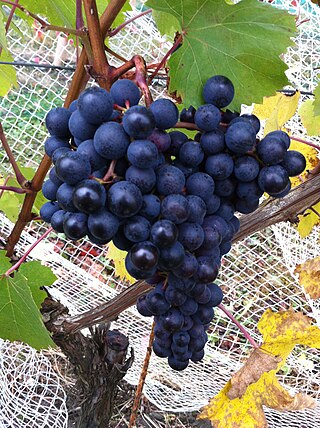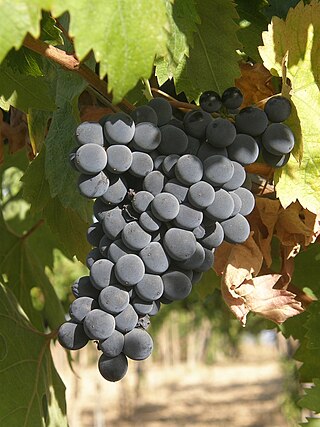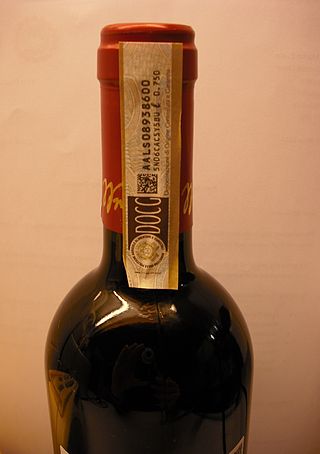This is a list of the 77 Italian DOCG (denominazione di origine controllata e garantita) wines ordered by region. [1] The four original DOCGs were Brunello, Vino Nobile, and Barolo (all approved by a presidential decree in July 1980) and Barbaresco (as approved in October 1980).

Chianti is an Italian red wine produced in the Chianti region of central Tuscany, principally from the Sangiovese grape. It was historically associated with a squat bottle enclosed in a straw basket, called a fiasco. However, the fiasco is now only used by a few makers of the wine; most Chianti is bottled in more standard-shaped wine bottles. In the latter nineteenth century, Baron Bettino Ricasoli helped establish Sangiovese as the blend's dominant grape variety, creating the blueprint for today's Chianti wines.

Dolcetto is a black Italian wine grape variety widely grown in the Piedmont region of northwest Italy. The Italian word dolcetto means "little sweet one", but it is not certain that the name originally carried any reference to the grape’s sugar levels: it is possible that it derives from the name of the hills where the vine is cultivated. In any case the wines produced are nearly always dry. They can be tannic and fruity with moderate, or decidedly low, levels of acidity and are typically meant to be consumed within a few years after release.

Montferrat is a historical region of Piedmont in Northern Italy. It comprises roughly the modern provinces of Alessandria and Asti. Montferrat is one of the most important wine districts of Italy. It also has a strong literary tradition, including the 18th century Asti-born poet and dramatist Vittorio Alfieri and the Alessandrian Umberto Eco.

Prosecco is an Italian DOC or DOCG white wine produced in a large area spanning nine provinces in the Veneto and Friuli Venezia Giulia regions, and named after the village of Prosecco, which is in the province of Trieste, Italy. It is made from the Prosecco grape but denomination rules allow up to 15% of the wine to be other permitted varieties. Prosecco is almost always made in sparkling or semi-sparkling style, but a still wine is also permitted. Within the larger designation are two small DOCG areas, Conegliano Valdobbiadene Prosecco in the hills between the towns of Conegliano and Valdobbiadene, and Asolo Prosecco around the nearby town of Asolo. Prosecco Superiore is always spumante and comes only from these DOCG areas.

Italian wine is produced in every region of Italy. Italy is the world's largest wine producer, as well as the country with the widest variety of indigenous grapevine in the world, with an area of 702,000 hectares under vineyard cultivation, and contributing a 2013–2017 annual average of 48.3 million hl of wine. In 2018 Italy accounted for 19 per cent of global production, ahead of France and Spain. Italian wine is both exported around the world and popular domestically among Italians, who consume an average of 42 litres per capita, ranking fifth in world wine consumption.

Soave is a dry white Italian wine from the Veneto region, in northeast Italy, principally around the city of Verona. Within the Soave region are both a denominazione di origine controllata (DOC) zone and, since 2001, a denominazione di origine controllata e garantita (DOCG) designation known as Soave Superiore, with both zones being further sub-divided into a general and Classico designation for the wines produced in the heartland of the Soave region, around the sloping vineyards of Verona.

Asti is a sparkling white Italian wine that is produced throughout southeastern Piedmont, but is particularly focused around the towns of Asti and Alba. Since 1993 the wine has been classified as a denominazione di origine controllata e garantita (DOCG) and as of 2004 was Italy's largest producing appellation. On an average vintage more than ten times as much Asti is produced in Piedmont than the more well-known Piedmontese red wine Barolo.

Costigliole d'Asti is a small Italian town in the Province of Asti, southern Piedmont. It lies about 13 kilometres south of the city of Asti in the Alto Monferrato, on the edge of the Langhe, in the alluvial plain of the river Tanaro southwards into the hills. The name derives from the Latin Corte Costeliolae.
Freisa is a red Italian wine grape variety grown in the Piedmont region of north-west Italy, primarily in Monferrato and in the Langhe, but also further north in the provinces of Turin and Biella. Freisa is a vigorous and productive vine whose round, blue-black grapes are harvested in early October. The three-lobed leaves are relatively small and the bunches are elongated in form. By the 1880s it had become one of the major Piedmontese grapes, and in that period its cultivation was stimulated by the vine’s resistance to the downy mildew caused by the Plasmopara viticola fungus. Wines made from the Freisa grape are red and usually somewhat sweet and lightly sparkling, or foaming. Still and fully sparkling versions are also produced, however, as are dry and more decidedly sweet styles. In the Canavese there is also a rosé which can be made primarily from Freisa according to Denominazione di origine controllata (DOC) regulations.

Roero is a geographical area in the north-east corner of the province of Cuneo in Piedmont, north-west Italy. This hilly region is known for its wines and for its fruit production: particularly the peaches of Canale and the local variety of pear known as Madernassa which originated in the late eighteenth century in Vezza d'Alba. Strawberries are also grown.

Moscato d'Asti is a DOCG sparkling white wine made from the Moscato bianco grape and produced mainly in the province of Asti, northwest Italy, and in smaller nearby regions in the provinces of Alessandria and Cuneo. The wine is sweet and low in alcohol, and is considered a dessert wine. A related wine, Asti, is produced in the same area from the same grape.

Brachetto is a red Italian wine grape variety grown predominantly in the Piedmont region of northwest Italy. At one time the grape was thought to be related to the French wine grape Braquet, but recent thought among ampelographers is that the two are distinct varieties. In Italy's region of Piedmont the grape is somewhat more widespread: production mostly falling within an area of the provinces of Asti and Alessandria between the rivers Bormida and Belbo plus various parts of the province of Cuneo. At Canelli, on the border between the hills of Asti and the Langhe proper, the grape is known as Borgogna. The most notable wine here is the red Brachetto d'Acqui Denominazione di Origine Controllata e Garantita (DOCG) which is made in both still and spumante versions. The Piemonte Brachetto Denominazione di Origine Controllata (DOC), also a red wine, is made with a minimum of 85% Brachetto; it is usually still, but may be frizzante. The grape is also used for up to 10% of the blend for the Ruché-based Ruché di Castagnole Monferrato DOCG.

Montepulciano is a red Italian wine grape variety that is most noted for being the primary grape behind the DOCG wines Colline Teramane Montepulciano d'Abruzzo and Offida Rosso; and the DOC wines Montepulciano d'Abruzzo, Rosso Conero, and Rosso Piceno Superiore.

Barbera d'Asti is an Italian red wine made from the Barbera grape. It is produced in the hilly areas of the provinces of Asti and Alexandria. Barbera d'Asti was accredited with DOC status in 1970, and DOCG status followed in 2008.
Cortese is a white Italian wine grape variety predominantly grown in the southeastern regions of Piedmont in the provinces of Alessandria and Asti. It is the primary grape of the Denominazione di origine controllata (DOC) wines of Cortese dell'Alto Monferrato and Colli Tortonesi as well as the Denominazione di Origine Controllata e Garantita (DOCG) wine of Cortese di Gavi. Significant plantings of Cortese can also be found in the Lombardy region of Oltrepò Pavese and in the DOC white blends of the Veneto wine region of Bianco di Custoza. Cortese has a long history in Italian viticulture with written documentation naming the grape among the plantings in a Piedmontese vineyard as early as 1659. The grape's moderate acidity and light flavors has made it a favorite for the restaurants in nearby Genoa as a wine pairing with the local seafood caught off the Ligurian coast.

Piemonte wine is the range of Italian wines made in the region of Piedmont, in the northwestern corner of Italy. The best-known wines from the region include Barolo and Barbaresco. They are made from the Nebbiolo grape. These wines are ideal for storage and a well-aged Barolo for instance may leave a feeling of drinking velvet because the tannins are polished and integrated more and more into the wine. As the wine matures the colour becomes more brownish and rust-red.

Tuscan wine is Italian wine from the Tuscany region. Located in central Italy along the Tyrrhenian coast, Tuscany is home to some of the world's most notable wine regions. Chianti, Brunello di Montalcino and Vino Nobile di Montepulciano are primarily made with Sangiovese grape whereas the Vernaccia grape is the basis of the white Vernaccia di San Gimignano. Tuscany is also known for the dessert wine Vin Santo, made from a variety of the region's grapes. Tuscany has forty-one Denominazioni di origine controllata (DOC) and eleven Denominazioni di Origine Controllata e Garantita (DOCG). In the 1970s a new class of wines known in the trade as "Super Tuscans" emerged. These wines were made outside DOC/DOCG regulations but were considered of high quality and commanded high prices. Many of these wines became cult wines. In the reformation of the Italian classification system many of the original Super Tuscans now qualify as DOC or DOCG wines but some producers still prefer the declassified rankings or to use the Indicazione Geografica Tipica (IGT) classification of Toscana. Tuscany has six sub-categories of IGT wines today.
The Colli Orientali del Friuli is a Denominazione di origine controllata (DOC) located in the Italian wine region of Friuli Venezia Giulia. The region is located in the province of Udine and is sub-divided into three main sections; Ramandolo in the north, Cialla and Corno di Rosazzo. The climate and soil is very similar to the neighboring DOC of Collio Goriziano and the two region share many winemaking similarities as well. The main distinction between the Colli Orientali del Friuli and Collio Goriziano lie in the increased red and dessert wine production of the Colli Orientali del Friuli. The region also includes within its boundaries the three Denominazione di origine controllata e garantita (DOCG) of the Friuli Venezia Giulia Ramandolo and the two passito wine DOCGs of Colli Orientali del Friuli Picolit and Colli Orientali del Friuli Picolit-Cialla.
{{cite web}}: CS1 maint: multiple names: authors list (link)